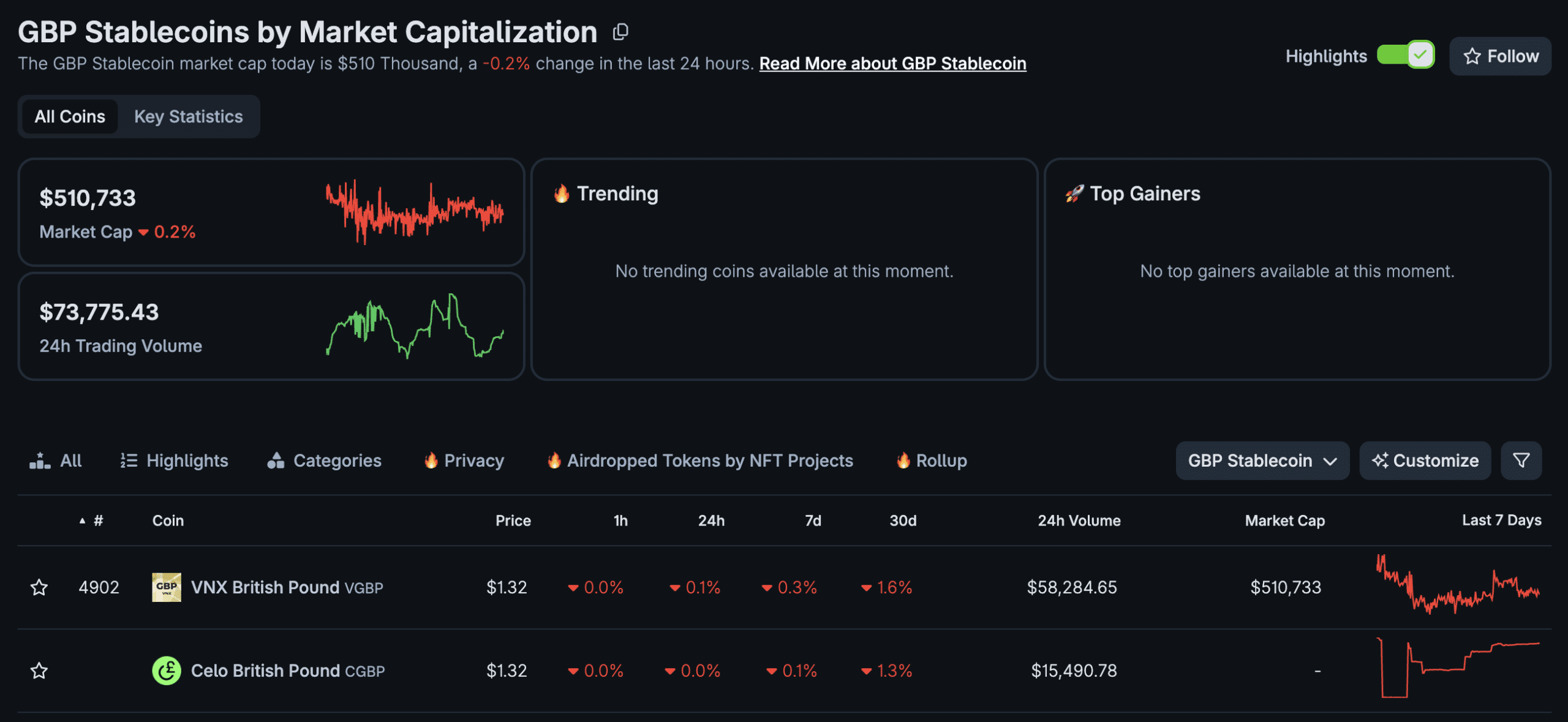The Bank of England’s Stablecoin regulatory framework for so-called systemic stablecoins was released today (November 10) in a consultation paper outlining its proposal.
There has been instant debate across Crypto Twitter over the exact remit of these so-called ‘systemic stablecoins’, which many have highlighted as intentionally vaguely worded – with the press release itself only referencing ‘UK stablecoins’.
One interpretation would see the term ‘systemic stablecoins’ as any listed for use on UK financial products such as exchanges, custodians, and DeFi protocols, or any stablecoin used in the payment of goods, services, or income to UK citizens.
The second interpretation draws on a single document headline that refers to ‘GBP-denominated stablecoins’. Although this is not clarified again in the document, which defers to a different organization, HM Treasury, to label ‘systemic stablecoins’, this suggests it draws the line at GBP-backed stablecoins.
Hilariously, there are currently two GBP-backed stablecoins, VGBP and CGBP, which hold a combined value of $500,000, with a daily trading volume of just $10,000 between the two – which illuminates a bigger question: has the Bank of England really spent 3 years investigating a market with a half-million market cap, or is this a soft-entry for a wider stablecoin regime?
The proposals are built upon feedback from the November 2023 Discussion Paper. While the BoE states that it is a commitment to public trust in money as payment innovations evolve, a UK stablecoin limit of £20,000 per individual tells a different story, as Kier Starmer and the UK Government continue to hinder the nation’s FinTech innovation.

In its press release, the BoE notes that the proposed framework will not cover stablecoins used for non-systemic purposes, and that non-systemic stablecoin issuers will be regulated by the FCA.
If recognised as systemic by HM Treasury (HMT), they will transition into the Bank’s regime and will be jointly regulated, with the Bank overseeing prudential and financial stability risks, and the FCA continuing to supervise conduct and consumer protection.
Key Policy Proposals Outlined in the Bank of England Paper: A Soft Entry Via Intentional Vagueness?
So what does systemic stablecoin mean?
The Bank of England paper clarifies that ‘systemic stablecoins’ are those widely used in payments, and are deemed to pose a risk to UK financial stability by HM Treasury.
Critically, the definition does not mention the GBP denomination; in fact, the only threshold required by this legal definition is that a stablecoin is used in payments in the UK.
The cynical view would be that this acts as a ‘soft-entry’ for a wider clamp-down on stablecoins, granting HM Treasury powers to classify, offering an easily extendible agency capture under the mask of the limited scope of the GBP stablecoin market.
After all, USD-denominated stablecoins dominate activity in UK crypto finance, serving as the primary trading pair on British exchanges and as the premier means of payment/settlement for the UK’s crypto natives.
And indeed, the British government isn’t new to this. Police in the UK have seized cryptocurrency, including stablecoin assets USDT and USDC, for years, so they’re well aware of the extent of USD-stablecoin proliferation.
Is The Bank of England Gunning For Your Crypto? Or Are UK Crypto Regulators Preparing for a Digital Shockwave?
In response to feedback, the BoE has stated that systemic stablecoin issuers will be allowed to hold up to 60% of their backing assets in short-term UK government debt. For the remaining 40%, the Bank will provide issuers with unremunerated accounts at the Bank of England, ensuring robust redemption and public confidence, even during stressful conditions.
Furthermore, issuers considered systemic at launch, or those transitioning from the FCA regime, will initially be permitted to hold up to 95% of their backing assets in short-term UK government debt to support their viability as they grow. This means that any firm creating a GBP-backed stablecoin under this framework must abide by the above ruleset.
In a new proposal, the Bank of England is also considering central bank liquidity arrangements to assist systemic stablecoin issuers during times of volatility. These arrangements would enhance financial stability by providing a safety net in case systemic issuers are unable to monetize their backing assets in private markets.
No, the Bank of England hasn’t set a £20,000 limit.
It’s a temporary proposal within its new consultation (published today) on systemic stablecoins, designed to manage risks from large outflows of bank deposits as digital money adoption grows.
The concern is that if too much…
— CryptoUK
(@CryptoUKAssoc) November 10, 2025
DISCOVER: The 12+ Hottest Crypto Presales to Buy Right Now
£20,000 Holding Limit: The True Centerpiece of the Bank of England Stablecoin Paper
The Bank of England has stated that the £20,000 holding limit per systemic GBP-backed stablecoin is intended to “Ensure continued access to credit as the financial system gradually adapts to new forms of digital money.”
A £10M holding limit has been proposed for businesses (with an exemption process to allow larger firms to hold more if necessary). These limits will reportedly be removed once the transition no longer poses risks to the provision of finance to the real economy. Additionally, these limits will not apply to stablecoins used for settling wholesale financial market transactions in the Bank and FCA’s Digital Securities Sandbox.
While the BoE has some pretty words for these holding limits, it is further evidence of the iron grip the UK is putting on its people, wrapping future GBP-backed stablecoins in red tape and restrictions that close them off as serious investment vehicles to the average person.
Coupled with the proposed digital ID cards, the UK is rolling full steam ahead in its bid for self-destruction by stifling FinTech innovation and simultaneously removing more of its people’s freedoms.
bank of england proposing a £20k cap on pound stablecoins is like putting a speed limit on unicycles, no-one is using them anyway
pic.twitter.com/3tL2aae5jU
— Ye Olde Intern (@blockscribbler) November 10, 2025
Smart Play to Avoid the Bank of England and Its Suffocating Stablecoin Restrictions
Quite simply, all one needs to do to avoid the Bank of England and its ridiculous £20,000 holding limit is to refuse outright to trade or hold any declared ‘systemic stablecoins’.
Why would anyone choose to hold a GBP-backed stablecoin, or if extended, an established USD-backed token, such as Tether’s USDT or Circle’s USDC, when the UK is taking steps to reduce access through outdated approaches to the adoption of digital assets?

With such a vast stablecoin industry, it seems likely that for years to come, there will be a plethora of freely accessible and liquid stablecoins not-yet declared ‘systemic’ to HODL wealth in (*cough* DAI *cough*).
For Brits, it is clear to see that the UK Government and the Bank of England are doing nothing to entice investors away from stablecoins; if anything, they are driving people deeper into the clutches of the obscure USD-denominated coins, prematurely killing any prospect of a digital GBP market.
The UK has a lot of catching up to do, as the combined USD-backed stablecoin market cap exceeds $300Bn, with a daily trading volume of over $113Bn. These numbers are expected to continue growing at a rapid pace as the US Government rolls out its GENIUS Act, which is expected to bring clarity and widespread adoption to its stablecoin sector.
EXPLORE: Next 1000X Crypto – Here’s 10+ Crypto Tokens That Can Hit 1000x This Year
Join The 99Bitcoins News Discord Here For The Latest Market Updates
The post Bank of England Restrict Stablecoin Limits to £20K: What is a ‘Systemic Stablecoin’? appeared first on 99Bitcoins.








